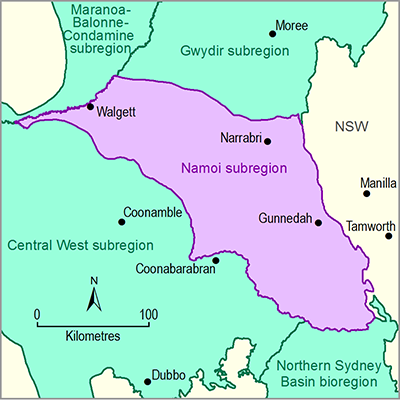Page 31 of 53
There are several data and knowledge gaps identified in this assessment of surface water – groundwater connectivity, including the need for:
- uncertainty analyses on the influence of monitoring bore density adjacent to the stream and the reliability of interpolated water level raster surfaces. A better understanding of the potential errors associated with field measurements and database errors (for example in groundwater elevations and standing water levels) and the implications for surface water and groundwater connectivity mapping would also be useful
- detailed elevation survey data, using lidar for example, that transect the stream–floodplain to enable more accurate analysis of surface water – groundwater connectivity
- monitoring infrastructure designed to collect field data relevant to the assessment of connectivity and water fluxes. The appropriately designed infrastructure would include a number of densely located instrumented riparian piezometer transects co-located with stream gauging stations. The co-location of instrumented nested piezometers and stream gauging stations would allow for the capture of time series data of stream stage height and groundwater levels over a range of hydrological events. These data would facilitate more detailed surface water – groundwater connectivity assessments and would lead to more robust estimates of infiltration rates along streams
- investigations of connection status, direction of flux and infiltration rates at various locations along stream reaches, especially in areas with the greatest resource pressures (Upper Namoi groundwater management zone 8 for example) using various techniques such as those outlined by Brownbill et al. (2011) and CSIRO and SKM (2012a). These techniques include hydrograph separation using environmental tracers and baseflow filtering, using methods such as Lyne and Hollick (1979); longitudinal stream sampling based on tracers and major ion chemistry in combination with detailed flow gauging; hydraulic gradient and flow net analysis; differential flow estimation and water balance investigations; streambed and geomorphological assessments; and integrated numerical modelling
- an assessment of the relationship between streamflow characteristics, climate variability, groundwater extraction, time lags and aquifer–stream connectivity in areas with the greatest resource pressures, such as groundwater management zone 8 of the Mooki river basin and the Quirindi creek basin, where stream reaches have been mapped as disconnected and transition to disconnected in this study, yet were previously mapped as connected. Smaller areas of disconnection and transition to disconnection require further investigation, including the Coxs creek basin (more widespread disconnection), and a region downstream of Carroll (showing both disconnection and transition to disconnection).
Moreover, comprehensively defining the connection between different geological basins and the role of large-scale development on groundwater resources in the Namoi subregion requires improving knowledge of (Welsh et al., 2014):
- the hydraulic connection between the shallow alluvial aquifers and underlying fractured rock aquifers in the deeper geological basins (Surat Basin, Gunnedah Basin). Although potential ‘windows’ of connectivity between these basins and between surface water and groundwater systems have been identified, the rates and processes of groundwater exchange remain unknown
- the controlling mechanisms for vertical leakage (cross-formational flow) for the multiple layers of aquifers and aquitards in the Namoi subregion. Understanding these mechanisms is critical for determining the effect of depressurisation required for CSG development in the subregion
- the hydraulic properties of aquitards and their response to changes in groundwater pressure within adjacent aquifers. Where multiple aquifer and aquitard layers are present, pressure changes caused by groundwater extraction will propagate at various rates and in various directions, depending on the physical and hydraulic properties of the aquifers and aquitards (Smerdon and Ransley, 2012).
Last updated:
6 December 2018

Summary and download
Product Finalisation date
2018
PRODUCT CONTENTS
- 2.1.1 Geography
- 2.1.2 Geology
- 2.1.3 Hydrogeology and groundwater quality
- 2.1.4 Surface water hydrology and water quality
- 2.1.5 Surface water – groundwater interactions
- 2.1.5.1 Observed data
- 2.1.5.2 Previous catchment-scale investigations on stream-aquifer interactions
- 2.1.5.3 Overview of controls on surface water – groundwater connectivity based on previous investigations in the Namoi river basin
- 2.1.5.4 Statistical analysis and interpolation
- 2.1.5.5 Gaps
- References
- Datasets
- 2.1.6 Water management for coal resource developments
- 2.1.6.1 Boggabri Coal Mine (baseline) and Boggabri Coal Expansion Project (ACRD)
- 2.1.6.2 Narrabri North Mine (baseline)
- 2.1.6.3 Narrabri South Project (ACRD)
- 2.1.6.4 Rocglen Mine (baseline)
- 2.1.6.5 Sunnyside Mine (baseline)
- 2.1.6.6 Tarrawonga Mine (baseline) and Tarrawonga Coal Expansion Project (ACRD)
- 2.1.6.7 Caroona Coal Project (ACRD)
- 2.1.6.8 Maules Creek Project (ACRD)
- 2.1.6.9 Watermark Coal Project (ACRD)
- 2.1.6.10 Vickery Coal Project (ACRD)
- 2.1.6.11 Narrabri Gas Project (ACRD)
- 2.1.6.12 Mine footprints
- References
- Datasets
- Citation
- Acknowledgements
- Currency of scientific results
- Contributors to the Technical Programme
- About this technical product
ASSESSMENT
ASSESSMENT COMPONENT
